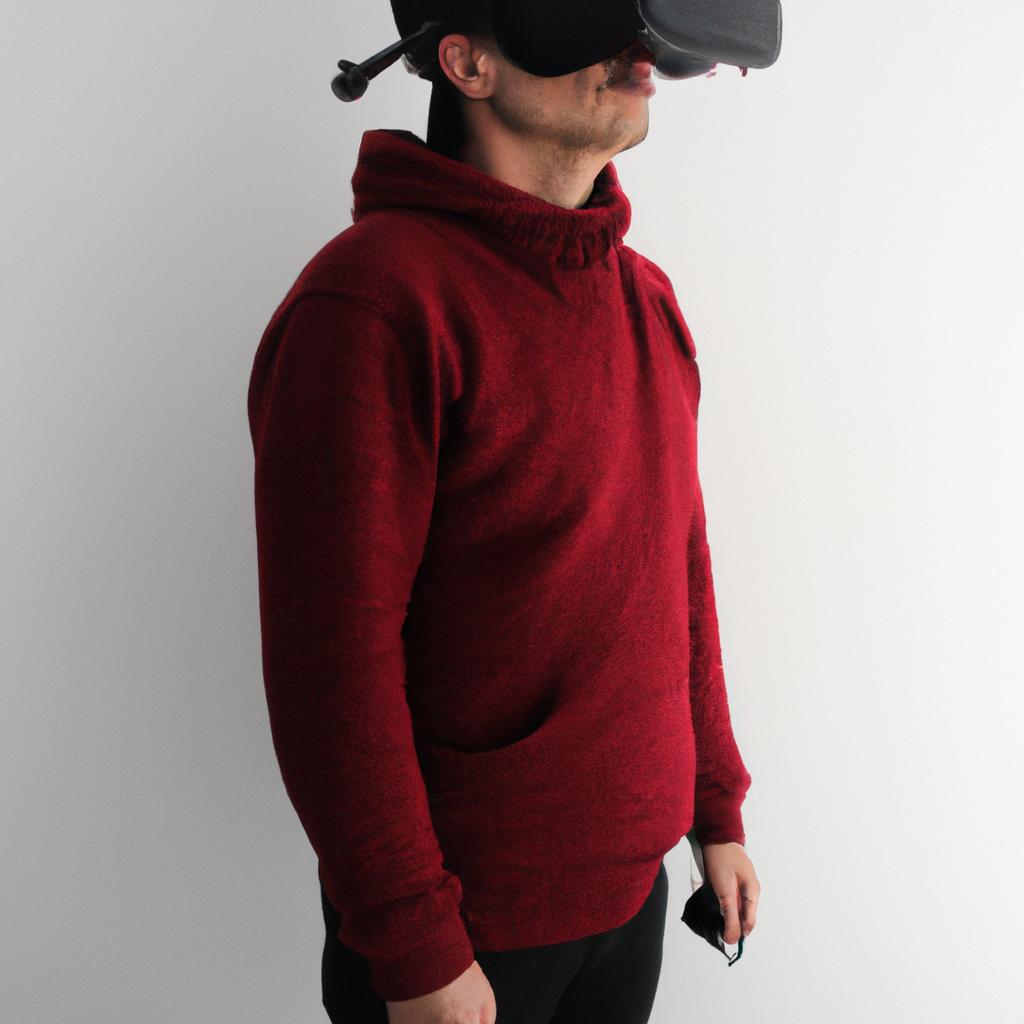Virtual Reality Games: The Future of Gaming in the Virtual Realm

Virtual reality (VR) games have emerged as a revolutionary trend in the field of gaming, offering players an immersive and interactive experience like never before. Imagine being transported to ancient mythical worlds, battling fierce creatures alongside legendary heroes, or exploring distant galaxies far beyond our own universe. One such example is the popular VR game “Elysium: The Lost City,” where players embark on a quest to uncover hidden treasures in a mystical realm. With advancements in technology and increasing accessibility, virtual reality games are poised to shape the future of gaming by transporting players into a hyper-realistic digital world.
The potential impact of virtual reality games on the gaming industry cannot be overstated. As traditional gaming increasingly becomes confined within screens and controllers, VR games break these boundaries by enabling users to physically engage with their surroundings through motion-tracking devices. By donning a VR headset and entering a fully simulated environment, gamers can interact with objects, manipulate their environments, and even communicate with other players from different corners of the globe. This level of immersion has revolutionized storytelling, allowing developers to create compelling narratives that not only captivate players but also give them agency over the course of events unfolding in front of them.
Moreover, virtual reality games offer numerous benefits beyond entertainment value alone. For instance , virtual reality games have been shown to have therapeutic applications in fields such as healthcare and mental health. By creating immersive and realistic simulations, VR games can be used for rehabilitation purposes, helping patients recover motor skills or overcome phobias through exposure therapy. Additionally, VR gaming has the potential to provide a safe and controlled environment for training in various industries, such as aviation or military, where high-risk scenarios can be simulated without real-world consequences.
In terms of gameplay experiences, virtual reality games offer unparalleled levels of engagement and presence. The ability to physically move within the game world and interact with objects creates a sense of embodiment that enhances immersion and emotional connection with the virtual environment. This heightened level of engagement not only provides a more enjoyable experience but also improves cognitive functions such as spatial awareness, problem-solving skills, and hand-eye coordination.
As technology continues to advance and become more affordable, virtual reality games are becoming increasingly accessible to a wider audience. With major players in the gaming industry investing heavily in VR development, we can expect an influx of innovative titles that push the boundaries of what is possible in gaming. From multiplayer cooperative experiences to solo adventures that transport players into entirely new worlds, virtual reality games have the potential to redefine how we play and experience video games.
However, it’s important to note that there are still some challenges associated with virtual reality gaming. High costs of entry equipment like headsets and motion controllers may limit accessibility for some gamers. Additionally, concerns about motion sickness or discomfort during extended use are factors that need to be addressed by developers. Nonetheless, as technology continues to improve and these challenges are overcome, virtual reality games will undoubtedly continue their rise as a dominant force in the gaming industry.
The Evolution of Gaming Technology
Virtual reality (VR) has revolutionized the gaming industry, providing players with immersive experiences that were once unimaginable. The rapid advancement in technology has propelled VR games into the forefront of interactive entertainment. By simulating a three-dimensional environment and enabling users to interact with it through specialized devices, VR games have transformed the way people play and experience video games.
To understand the evolution of gaming technology, let us consider an example: the Oculus Rift. Introduced in 2016, this virtual reality headset gained widespread popularity due to its ability to create realistic and captivating game environments. With its high-resolution display, precise tracking sensors, and ergonomic design, the Oculus Rift offered gamers a truly immersive experience like never before.
The rise of VR games can be attributed to several key factors:
-
Enhanced Realism: Virtual reality allows players to step into a digital world that feels incredibly real. Through advanced graphics, sound effects, and haptic feedback systems, VR games engage multiple senses simultaneously. This heightened realism creates a sense of presence and immersion for players, blurring the line between the physical and virtual realms.
-
Unique Gameplay Mechanics: In addition to improved visual and auditory elements, VR games introduce innovative gameplay mechanics that take advantage of motion controls and spatial awareness. Players can physically move within the game space, manipulate objects using hand gestures or controllers, and perform actions as if they were part of the virtual environment.
-
Social Interaction: Virtual reality also offers opportunities for social interaction within gaming communities. Multiplayer VR games allow players from different locations to meet virtually in shared spaces where they can collaborate or compete against each other in real-time. This aspect adds a new dimension to traditional multiplayer gaming experiences by promoting social engagement and fostering connections among players worldwide.
-
Experiential Variety: From thrilling action-adventure titles to serene explorations of artistic landscapes, VR games offer a wide range of experiences catering to diverse player preferences. Whether it’s battling enemies in a post-apocalyptic world or solving puzzles in an enchanted forest, virtual reality enables gamers to step into various scenarios and live out their wildest fantasies.
- Immerse yourself in lifelike environments.
- Interact with the game using intuitive motion controls.
- Connect and play with friends from around the world.
- Explore different genres and experiences tailored to your interests.
Markdown Table:
| Feature | Description |
|---|---|
| Enhanced Realism | Engaging graphics, sound effects, and haptic feedback systems that create a sense of presence |
| Unique Gameplay | Innovative mechanics utilizing motion controls and spatial awareness |
| Social Interaction | Multiplayer capabilities allowing players worldwide to collaborate or compete |
| Experiential Variety | Diverse range of gaming experiences across multiple genres |
In summary, virtual reality games represent a significant leap forward in gaming technology. With enhanced realism, unique gameplay mechanics, social interaction opportunities, and experiential variety, VR games offer an unparalleled level of immersion for players. In the subsequent section about “Immersive Experiences: How Virtual Reality Games Transform Gameplay,” we will delve deeper into how these advancements have transformed traditional gaming experiences.
Immersive Experiences: How Virtual Reality Games Transform Gameplay
Section: Virtual Reality Games: The Future of Gaming in the Virtual Realm
In recent years, technology has propelled the gaming industry into new frontiers, offering players experiences that were once unimaginable. One such advancement is virtual reality (VR) gaming, which transports users into immersive digital environments through the use of specialized headsets and motion-tracking equipment. As this technology continues to evolve and become more accessible, it holds immense potential for revolutionizing the way we play games.
To illustrate this potential, let us consider a hypothetical scenario where a player dons a VR headset and enters a game set in an ancient Egyptian civilization. With every step they take, they can explore intricate pyramids, interact with lifelike characters, and solve puzzles as if transported back in time. Such immersive experiences not only entertain but also educate players about historical cultures and foster empathy by allowing them to walk in someone else’s shoes.
The impact of virtual reality games extends beyond mere entertainment value. They have the power to fundamentally transform gameplay itself. Here are some key ways in which VR enhances the gaming experience:
- Unprecedented Immersion: By creating a sense of presence within the digital world, VR draws players deeper into their gaming environment than ever before.
- Physical Engagement: With motion tracking sensors detecting real-world movements, players can physically duck behind cover or swing swords with their own hands, adding a new level of physicality to gameplay.
- Social Interaction: Multiplayer VR games allow friends from around the globe to meet up virtually within shared worlds and engage in cooperative or competitive challenges together.
- Emotional Impact: Through realistic graphics and immersive sound design, VR games evoke powerful emotions such as fear, excitement, joy, or awe in ways traditional gaming cannot replicate.
This table demonstrates how virtual reality compares to conventional gaming techniques:
| Conventional Gaming | Virtual Reality | |
|---|---|---|
| Interaction | Primarily controller-based input | Full-body motion tracking and hand gestures |
| Perspective | Third-person or first-person view | First-person perspective, providing a more immersive experience |
| Sensory Input | Visual and auditory feedback | Enhanced visual, auditory, and haptic feedback |
| Social Aspect | Online multiplayer or local co-op play | Virtual meetups and shared experiences in the same digital space |
As virtual reality technology continues to advance, exploring its potential within gaming becomes increasingly crucial. The next section will delve deeper into how VR can push the boundaries of interactive entertainment, paving the way for exciting possibilities that were once confined to our imaginations.
[Transition Sentence] Looking ahead, we now turn our attention towards exploring the potential of virtual reality in gaming.
Exploring the Potential of Virtual Reality in Gaming
Imagine stepping into a virtual world where you can become the hero of your favorite video game, battling enemies and exploring new worlds with unprecedented realism. This is now possible thanks to the rise of virtual reality (VR) games. By immersing players in fully interactive digital environments, VR games have revolutionized how we experience gaming. In this section, we will delve deeper into the transformative nature of VR games and explore their potential for enhancing gameplay.
One example that showcases the power of VR in transforming gameplay is “Half-Life: Alyx.” Released in 2020 by Valve Corporation, this highly acclaimed VR game takes players on an immersive journey through a post-apocalyptic city infested with alien creatures. Players navigate through detailed environments using hand controllers and headsets, feeling as if they are physically present within the game’s world. The level of immersion provided by “Half-Life: Alyx” demonstrates just how far VR technology has come in creating truly captivating experiences.
The impact of virtual reality on gaming goes beyond mere immersion; it also opens up new possibilities for interactivity and exploration. Here are some key ways in which VR games transform gameplay:
- Physical engagement: Unlike traditional gaming experiences that rely primarily on button presses or mouse movements, VR games require players to physically interact with their surroundings. Whether it’s picking up objects, swinging swords, or solving puzzles through gestures, these physical interactions add a whole new layer of depth to gameplay.
- Spatial awareness: With the help of room-scale tracking systems, VR games allow players to move freely within their play space while accurately mapping those movements onto their virtual avatars. This enhances spatial awareness and provides a sense of presence that simply cannot be replicated by conventional gaming setups.
- Emotional connection: The combination of immersive visuals and realistic audio in VR games creates an emotional bond between players and the virtual world they inhabit. From heart-pounding moments of suspense to awe-inspiring sights, VR games have the potential to evoke a wide range of emotions, making the gaming experience all the more captivating.
- Social interaction: While gaming has always been a social activity, VR takes it to a whole new level. With multiplayer VR experiences, players can engage with friends and strangers alike in virtual worlds that feel incredibly lifelike. This fosters collaboration, competition, and community building among gamers.
To further illustrate the transformative power of VR games, consider the following table:
| Virtual Reality Games | Traditional Games |
|---|---|
| Immersive gameplay | Limited immersion |
| Physical interactivity | Button-based controls |
| Spatial awareness | Restricted movement |
| Emotional connection | Limited emotional impact |
As seen in this comparison table, VR games provide an unparalleled level of immersion and interactivity compared to traditional games. The incorporation of physicality and spatial awareness elevates gameplay to new heights while fostering emotional connections between players and virtual environments.
In light of these advancements in technology and gameplay experiences offered by VR games, developers continuously strive to overcome challenges faced by users.
Overcoming Challenges: Enhancing User Experience in Virtual Reality Games
Imagine being transported into a mystical world, where you can battle fierce dragons or explore ancient ruins without leaving the comfort of your own home. This is the power of virtual reality (VR) gaming – an immersive experience that has captured the attention of both gamers and developers alike. In this section, we will further delve into the potential of VR in gaming by examining its impact on user engagement, storytelling, and social interaction.
One notable case study demonstrating the potential of VR in gaming is “The Elder Scrolls V: Skyrim VR.” Released in 2017, this game allowed players to step into the vast open-world environment of Skyrim using a VR headset. With the ability to physically swing swords or cast spells with hand movements, players were fully immersed in their virtual adventures like never before. The success of games like “Skyrim VR” highlights how VR technology can enhance user engagement by creating a new level of realism and interactivity.
To better understand the possibilities offered by VR gaming, let us consider some key aspects:
- Enhanced Immersion: Through realistic graphics and responsive controls, VR provides a heightened sense of immersion that traditional gaming cannot replicate.
- Emotional Impact: By placing players directly within the game’s virtual world, VR experiences have greater potential to evoke emotional responses such as fear, excitement, or empathy.
- Interconnectedness: Multiplayer capabilities allow for shared experiences in virtual spaces, fostering social interactions among players from different locations.
- Innovative Storytelling: With interactive narratives tailored specifically for VR environments, developers have an opportunity to create unique storytelling experiences that captivate players on a whole new level.
Table 1 illustrates how these factors contribute to an enhanced gaming experience through virtual reality:
| Aspect | Description | Effect |
|---|---|---|
| Enhanced Immersion | Realistic graphics and responsive controls provide a heightened sense of presence in the virtual world. | Increased engagement and immersion. |
| Emotional Impact | Being physically present within a game can evoke strong emotional responses, enhancing the overall experience. | Deeper connection to characters and narrative. |
| Interconnectedness | Multiplayer capabilities enable players to interact with others in real-time, fostering social connections across distances. | Enhanced sense of community and shared experiences. |
| Innovative Storytelling | VR allows for interactive narratives tailored specifically for the medium, creating unique storytelling experiences. | Engaging plots that captivate players on a deeper level. |
In conclusion, virtual reality gaming has immense potential to revolutionize the way we experience games by providing enhanced immersion, evoking emotional responses, promoting social interactions, and offering innovative storytelling opportunities. As technology continues to advance and VR becomes more accessible, it is clear that this immersive form of entertainment will play a significant role in shaping the future of interactive gaming.
Next Section: Overcoming Challenges: Enhancing User Experience in Virtual Reality Games
Virtual Reality Games and the Future of Interactive Entertainment
Virtual reality (VR) games have come a long way in enhancing user experience and redefining the future of gaming. With immersive graphics, realistic simulations, and interactive gameplay, VR games have captivated players worldwide. However, despite these advancements, there are still challenges to overcome in order to further enhance the user experience.
One example of a challenge faced by VR game developers is motion sickness experienced by some users. This occurs when there is a discrepancy between what users see in the virtual world and how they physically perceive movement in the real world. To address this issue, developers have been working on improving frame rates and reducing latency to minimize motion sickness. Additionally, implementing techniques such as teleportation or smooth locomotion options can provide users with more control over their movements within the virtual environment.
To further enhance user experience in VR games, developers are focusing on creating more realistic interactions with objects and characters. For instance, haptic feedback technology allows users to feel physical sensations through vibrations or force feedback devices. This enables them to better immerse themselves in the virtual world and enhances the overall sense of presence. Furthermore, advancements in gesture recognition technology enable users to interact with the virtual environment using natural hand movements instead of relying solely on traditional controllers.
In addition to overcoming technical challenges, VR game developers must also consider factors that contribute to emotional engagement for players. Research has shown that emotional responses play a crucial role in shaping memorable gaming experiences. To evoke an emotional response from players, developers can incorporate elements such as:
- Engaging storytelling: Crafting compelling narratives that resonate with players’ emotions.
- Character customization: Allowing players to personalize their avatars and create a deeper connection with their virtual identities.
- Dynamic sound design: Utilizing audio cues and atmospheric effects to heighten immersion and elicit emotional reactions.
- Multiplayer interaction: Facilitating social connections through multiplayer features that enable cooperative or competitive gameplay.
Table 1:
| Elements for Emotional Engagement |
|---|
| Engaging storytelling |
| Character customization |
| Dynamic sound design |
| Multiplayer interaction |
In conclusion, while VR games have made significant strides in enhancing user experience, there are still challenges to overcome. By addressing issues such as motion sickness and improving realism through haptic feedback and gesture recognition technology, developers can create more immersive experiences for players. Additionally, incorporating elements that evoke emotional engagement can further enhance the overall impact of VR games on players’ enjoyment.
The next section will explore the impact of virtual reality games on the gaming industry, highlighting the ways in which this emerging technology is reshaping the landscape of interactive entertainment.
The Impact of Virtual Reality Games on the Gaming Industry
Virtual reality games have significantly transformed the landscape of interactive entertainment, revolutionizing the way players engage with digital worlds. As technology continues to advance, virtual reality (VR) has become more accessible and immersive, opening up new possibilities for game developers and enthusiasts alike. This section explores the impact of VR games on the gaming industry by examining their potential for enhanced immersion, realistic experiences, and social interactions.
One notable example that exemplifies the power of VR games is “The Elder Scrolls V: Skyrim VR.” Originally released as a traditional role-playing game in 2011, it was later adapted into a virtual reality version for popular platforms such as PlayStation VR. Players can now don their headsets and physically explore the vast open world of Skyrim, wielding weapons, casting spells, and engaging in combat like never before. This transition from traditional gameplay to full-scale immersion showcases the transformative nature of VR games.
To better understand how virtual reality games are shaping the future of interactive entertainment, consider these key aspects:
- Immersive Environments: Through advanced graphics and spatial audio technologies, VR games transport players into fully realized environments that stimulate all senses. Whether exploring ancient ruins or racing through futuristic cities, players experience an unparalleled sense of presence.
- Realistic Experiences: By leveraging motion tracking systems and haptic feedback devices, VR games offer users a heightened level of realism. From mimicking real-world physics to simulating tactile sensations during gameplay, these advancements enhance player engagement and make experiences feel more authentic.
- Interconnected Social Interactions: Virtual reality multiplayer modes allow players from different locations to interact within shared digital spaces. These connections foster collaboration and competition among gamers worldwide while fostering a sense of community even when physically apart.
| Advantages | Disadvantages | Opportunities | Challenges |
|---|---|---|---|
| Enhanced immersion | Limited availability of VR devices | Broadening target audience | High cost of entry |
| Realistic experiences | Potential health risks (motion sickness) | New gameplay mechanics | Technological limitations |
| Social interactions beyond physical boundaries | Learning curve for new players | Cross-platform compatibility | Ensuring user comfort and safety |
The impact of virtual reality games on the gaming industry is profound. As more developers embrace this technology, we can expect further advancements in immersive storytelling, innovative gameplay mechanics, and interactive social experiences. The continuous evolution of VR will undoubtedly shape the future of gaming by blurring the lines between fantasy worlds and reality, while also presenting unique challenges that must be addressed to fully unlock its potential.
In light of these developments, it becomes clear that virtual reality games hold immense promise as a catalyst for transformative experiences within the realm of interactive entertainment. By pushing technological boundaries and redefining how players engage with digital content, VR represents an exciting frontier that has only just begun to be explored by both developers and consumers alike.








